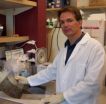(Press-News.org) BOSTON--A new oral drug caused dramatic shrinkage of a patient's rare, aggressive form of soft-tissue cancer that was driven by an abnormally activated protein, physician-scientists from Dana-Farber Cancer Institute report in the Oct. 28 issue of the New England Journal of Medicine.
A second patient who had a similar tumor that was not fueled by the mutant protein, called ALK (named for the first disease in which it was found, anaplastic lymphoma kinase), failed to respond to the drug, said the researchers, confirming the inhibitor's specificity for the abnormal protein. The findings also highlight the value of "personalized medicine" gene-testing strategies to predict the best drug treatment for an individual's particular, genetically defined cancer.
The patient described in the NEJM Brief Report is a 44-year-old man diagnosed in 2007 with inflammatory myofibroblastic tumor (IMT), a type of sarcoma that typically develops in the chest or abdomen in children and young adults.
In approximately half the cases of IMT, ALK is fused to a different protein in the patients' cancer cells, spurring cancer development. The patient had been treated with standard chemotherapy drugs followed by the targeted compound Gleevec, but the cancer returned in the form of multiple tumors.
James Butrynski, MD and Geoffrey Shapiro, MD, PhD, Dana-Farber oncologists and the first and senior authors of the report, respectively, offered the patient participation in a Phase 1 trial of an experimental drug, crizotinib, which blocks ALK activity, as well as that of another oncogene, MET, that is abnormally activated in a number of cancers.
Crizotinib treatment shrank the tumors by more than 50 percent – technically called a "partial response." After several months of crizotinib, in December 2008, some of the tumors became resistant to the drug and started growing again. These tumors, as well as tumors still responsive to crizotinib, were removed surgically. Crizotinib was resumed after the surgery, and the patient remains without evidence of disease as of September 2010, according to the investigators.
The activity of crizotinib goes beyond this rare sarcoma. The current report accompanies a paper in the same journal describing striking activity of crizotinib in a group of patients with non-small cell lung cancers (NSCLC) containing the abnormal ALK protein. Researchers from Massachusetts General Hospital, Dana-Farber/Brigham and Women's Cancer Center, and other hospitals gave crizotinib to 82 patients after standard drugs failed to halt the tumors' growth. As part of the personalized medicine effort ongoing in the Dana-Farber/Brigham and Women's Cancer Center Thoracic Oncology Program, patients with abnormal ALK were identified for the trial, underscoring the importance of tumor profiling to match drug with patient.
Results showed that 47 patients had tumor shrinkage (complete disappearance in one patient) and the cancer stopped growing in 27 patients. The ALK rearrangements are found in a small subset, about 5 percent, of patients with NSCLC, but scientists are searching for other cancers that may also be susceptible to the ALK inhibitor.
Shapiro noted that even highly successful targeted drugs like crizotinib are vulnerable to tumors' developing resistance against them. In fact, the IMT patient's tumors that developed resistance to crizotinib and were removed surgically have been studied by one of the reports co-authors, Pasi Janne, MD, PhD, also of Dana-Farber. In a paper appearing simultaneously in Cancer Research, Janne and his colleagues have identified a secondary mutation in ALK in the patient's tumor that conferred resistance to crizotinib. Furthermore, in work recently published by Janne, Shapiro and their Dana-Farber colleague, Kwok-Kin Wong, MD, PhD, the abnormal ALK proteins, including the protein with the secondary mutation that was resistant to crizotinib, were found to depend on a cellular chaperone, called Hsp90, for their stability. Inhibitors of Hsp90 are currently under clinical evaluation and have been shown to cause destruction of the aberrant ALK proteins.
Crizotinib is one of many targeted agents currently being evaluated by the Early Drug Development Center within the Experimental Therapeutics Program at Dana-Farber, with the aim of translating the best science into effective new therapies for patients with many forms of cancer that can be defined by sophisticated new molecular profiling techniques.
INFORMATION:
Authors of the NEJM Brief Report, in addition to Shapiro, Butrynski, and Janne, include co-senior author George Demetri, MD, and Marzia Capelletti, PhD, Dana-Farber; Nikhil Ramaiya, MD, Dana-Farber/Brigham and Women's; and Jason Hornick, MD, PhD, Paola Dal Sin, PhD, and Scott Rodig, MD, PhD, Brigham and Women's, as well as researchers from other hospitals and Pfizer Global Research and Development.
The work was supported in part by Pfizer as well as the National Institutes of Health.
Dana-Farber Cancer Institute (www.dana-farber.org) is a principal teaching affiliate of the Harvard Medical School and is among the leading cancer research and care centers in the United States. It is a founding member of the Dana-Farber/Harvard Cancer Center (DF/HCC), designated a comprehensive cancer center by the National Cancer Institute. It provides adult cancer care with Brigham and Women's Hospital as Dana-Farber/Brigham and Women's Cancer Center and it provides pediatric care with Children's Hospital Boston as Dana-Farber/Children's Hospital Cancer Center. Dana-Farber is the top ranked cancer center in New England, according to U.S. News & World Report, and one of the largest recipients among independent hospitals of National Cancer Institute and National Institutes of Health grant funding.
'Smart drug' targets new mutation, dramatically shrinks aggressive sarcoma and lung cancer
Patient's response was predicted by test for mutant protein in tumor cells
2010-10-28
ELSE PRESS RELEASES FROM THIS DATE:
New methods detect subtleties in human genomes' repetitive landscapes
2010-10-28
Scientists have invented methods to scout the human genome's repetitive landscapes, where DNA sequences are highly identical and heavily duplicated. These advances, as reported today in Science, can identify subtle but important differences among people in the number and content of repeated DNA segments.
These copy number variations partly account for the normal diversity among people. Copy number variations might also be why some people, and not others, have certain disorders or disease susceptibilities, and might also determine how severely they are affected.
Until ...
Certain cancer therapies' success depends on presence of immune cell, Stanford study shows in mice
2010-10-28
STANFORD, Calif. — The immune system may play a critical role in ensuring the success of certain types of cancer therapies, according to a new study by researchers at the Stanford University School of Medicine. The research showed treatments that disable cancer-promoting genes called oncogenes are much more successful in eradicating tumors in the presence of a signaling molecule secreted by kind of immune cell called a T helper cell.
The finding is important because many drugs now in use in humans are often tested in lab animals with weakened immune systems and many human ...
Controlling individual cortical nerve cells by human thought
2010-10-28
PASADENA, Calif.—Five years ago, neuroscientist Christof Koch of the California Institute of Technology (Caltech), neurosurgeon Itzhak Fried of UCLA, and their colleagues discovered that a single neuron in the human brain can function much like a sophisticated computer and recognize people, landmarks, and objects, suggesting that a consistent and explicit code may help transform complex visual representations into long-term and more abstract memories.
Now Koch and Fried, along with former Caltech graduate student and current postdoctoral fellow Moran Cerf, have found ...
Revising the timeline for deadly pancreatic cancer
2010-10-28
Pancreatic tumors are one of the most lethal cancers, with fewer than five percent of patients surviving five years after diagnosis. But a new study that peers deeply into the genetics of pancreatic cancer presents a bit of good news: an opportunity for early diagnosis. In contrast to earlier predictions, many pancreatic tumors are, in fact, slow growing, taking nearly 20 years to become lethal after the first genetic perturbations appear.
"There have been two competing theories explaining why pancreatic cancers are so lethal," says Bert Vogelstein, the Howard Hughes ...
1000 Genomes Project publishes analysis of completed pilot phase
2010-10-28
Small genetic differences between individuals help explain why some people have a higher risk than others for developing illnesses such as diabetes or cancer. Today in the journal Nature, the 1000 Genomes Project, an international public-private consortium, published the most comprehensive map of these genetic differences, called variations, estimated to contain approximately 95 percent of the genetic variation of any person on Earth.
Researchers produced the map using next-generation DNA sequencing technologies to systematically characterize human genetic variation ...
Large-scale fish farm production offsets environmental gains
2010-10-28
VICTORIA – Industrial-scale aquaculture production magnifies environmental degradation, according to the first global assessment of the effects of marine finfish aquaculture (e.g. salmon, cod, turbot and grouper) released today. This is true even when farming operations implement the best current marine fish farming practices.
Dr. John Volpe and his team at the University of Victoria developed the Global Aquaculture Performance Index (GAPI), an unprecedented system for objectively measuring the environmental performance of fish farming.
"Scale is critical," said Dr. ...
Spiral galaxies stripped bare
2010-10-28
HAWK-I [1] is one of the newest and most powerful cameras on ESO's Very Large Telescope (VLT). It is sensitive to infrared light, which means that much of the obscuring dust in the galaxies' spiral arms becomes transparent to its detectors. Compared to the earlier, and still much-used, VLT infrared camera ISAAC, HAWK-I has sixteen times as many pixels to cover a much larger area of sky in one shot and, by using newer technology than ISAAC, it has a greater sensitivity to faint infrared radiation [2]. Because HAWK-I can study galaxies stripped bare of the confusing effects ...
Singapore scientist leads team to discover origin of brain immune cells
2010-10-28
A team of international scientists led by Dr Florent Ginhoux of the Singapore Immunology Network (SIgN) of Singapore's Agency of Science, Technology and Research (A*STAR), have made a breakthrough that could lead to a better understanding of many neurodegenerative and inflammatory brain disorders. Their work, published in top scientific journal Science, uncovered the origins of microglia, which are white blood cells specific to the brain, and showed that, in mice, microglia had a completely different origin than other white blood cells. This understanding may lead to the ...
Narcotics and diagnostics overused in treatment of chronic neck pain
2010-10-28
Duke University and University of North Carolina (UNC) researchers report in the November issue of Arthritis Care & Research that narcotics and diagnostic testing are overused in treating chronic neck pain. Their findings indicate clinicians may overlook more effective treatments for neck pain, such as therapeutic exercise. According to reviews cited in the study, evidence to support the effectiveness of therapeutic exercise in treating chronic neck pain is good, yet only 53% of subjects were prescribed such exercise. This information was based upon reported data from a ...
Learning the truth not effective in battling rumors about NYC mosque, study finds
2010-10-28
COLUMBUS, Ohio – Evidence is no match against the belief in false rumors concerning the proposed Islamic cultural center and mosque near Ground Zero in New York City, a new study finds.
Researchers at Ohio State University found that fewer than one-third of people who had previously heard and believed one of the many rumors about the proposed center changed their minds after reading overwhelming evidence rejecting the rumor.
The false rumor that researchers used in the study was that Feisal Abdul Rauf, the Imam backing the proposed Islamic cultural center and mosque, ...
LAST 30 PRESS RELEASES:
New expert guidance urges caution before surgery for patients with treatment-resistant constipation
Solar hydrogen can now be produced efficiently without the scarce metal platinum
Sleeping in on weekends may help boost teens’ mental health
Study: Teens use cellphones for an hour a day at school
After more than two years of war, Palestinian children are hungry, denied education and “like the living dead”
The untold story of life with Prader-Willi syndrome - according to the siblings who live it
How the parasite that ‘gave up sex’ found more hosts – and why its victory won’t last
When is it time to jump? The boiling frog problem of AI use in physics education
Twitter data reveals partisan divide in understanding why pollen season's getting worse
AI is quick but risky for updating old software
Revolutionizing biosecurity: new multi-omics framework to transform invasive species management
From ancient herb to modern medicine: new review unveils the multi-targeted healing potential of Borago officinalis
Building a global scientific community: Biological Diversity Journal announces dual recruitment of Editorial Board and Youth Editorial Board members
Microbes that break down antibiotics help protect ecosystems under drug pollution
Smart biochar that remembers pollutants offers a new way to clean water and recycle biomass
Rice genes matter more than domestication in shaping plant microbiomes
Ticking time bomb: Some farmers report as many as 70 tick encounters over a 6-month period
Turning garden and crop waste into plastics
Scientists discover ‘platypus galaxies’ in the early universe
Seeing thyroid cancer in a new light: when AI meets label-free imaging in the operating room
Neutrophil-to-lymphocyte ratio may aid risk stratification in depressive disorder
2026 Seismological Society of America Annual Meeting
AI-powered ECG analysis offers promising path for early detection of chronic obstructive pulmonary disease, says Mount Sinai researchers
GIMM uncovers flaws in lab-grown heart cells and paves the way for improved treatments
Cracking the evolutionary code of sleep
Medications could help the aging brain cope with surgery, memory impairment
Back pain linked to worse sleep years later in men over 65, according to study
CDC urges ‘shared decision-making’ on some childhood vaccines; many unclear about what that means
New research finds that an ‘equal treatment’ approach to economic opportunity advertising can backfire
Researchers create shape-shifting, self-navigating microparticles
[Press-News.org] 'Smart drug' targets new mutation, dramatically shrinks aggressive sarcoma and lung cancerPatient's response was predicted by test for mutant protein in tumor cells



